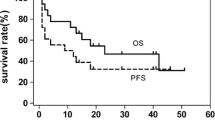Abstract
Myeloid/natural killer (NK) cell precursor acute leukemia (MNKPL) is a rare leukemia subtype that possibly originates from precursor NK cells. The disease has a poor prognosis, and information on its treatment is lacking. We herein report the first case of a 46-year-old woman with MNKPL who was refractory to two lines of acute myeloid leukemia (AML)-type intensive chemotherapy but was successfully treated with venetoclax and azacytidine (VEN/AZA). She was diagnosed with MNKPL based on the conformations of immature lymphoblastoid morphology without myeloperoxidase reactivity that showed a CD7/CD33/CD34/CD56/HLA-DR positive phenotype and extramedullary regions. The disease was refractory to induction therapy with daunorubicin and cytarabine (DNR/Ara-C) and to reinduction therapy with mitoxantrone, etoposide, and cytarabine (MEC). After two lines of induction chemotherapy, massive pericardial and pleural effusion was found, and was suspected to be extramedullary lesions. The patient developed cardiac tamponade and required pericardiocentesis. Thus, VEN/AZA was administered as third-line therapy. After two cycles of VEN/AZA, the pericardial and pleural effusion disappeared, and complete remission was achieved. The patient received post-transplant cyclophosphamide-based haploidentical transplantation and has stayed relapse-free as of her last follow-up examination 2 years after diagnosis.




Similar content being viewed by others
Data availability
Data sharing is not applicable to this article as no datasets were generated or analyzed during the current study.
References
Suzuki R, Yamamoto K, Seto M, Kagami Y, Ogura M, Yatabe Y, et al. CD7+ and CD56+ myeloid/natural killer cell precursor acute leukemia: a distinct hematolymphoid disease entity. Blood. 1997;90(6):2417–28.
Oshimi K. Progress in understanding and managing natural killer-cell malignancies. Br J Haematol. 2007;139(4):532–44.
Swerdlow SH, Campo E, Harris NL, Jaffe ES, Pileri SA, Stein H, et al. WHO classification of tumours of haematopoietic and lymphoid tissues. Lyon: IARC Press; 2017.
Suzuki R, Murata M, Kami M, Ohtake S, Asou N, Kodera Y, et al. Prognostic significance of CD7+CD56+ phenotype and chromosome 5 abnormalities for acute myeloid leukemia M0. Int J Hematol. 2003;77(5):482–9.
Suzuki R, Nakamura S. Malignancies of natural killer (NK) cell precursor: myeloid/NK cell precursor acute leukemia and blastic NK cell lymphoma/leukemia. Leuk Res. 1999;23(7):615–24.
Noguchi Y, Tomizawa D, Hiroki H, Miyamoto S, Tezuka M, Miyawaki R, et al. Hematopoietic cell transplantation for myeloid/NK cell precursor acute leukemia in second remission. Clin Case Rep. 2018;6(6):1023–8.
Coustan-Smith E, Mullighan CG, Onciu M, Behm FG, Raimondi SC, Pei D, et al. Early T-cell precursor leukaemia: a subtype of very high-risk acute lymphoblastic leukaemia. Lancet Oncol. 2009;10(2):147–56.
Fuhrmann S, Schabath R, Möricke A, Zimmermann M, Kunz JB, Kulozik AE, et al. Expression of CD56 defines a distinct subgroup in childhood T-ALL with inferior outcome. Results of the ALL-BFM 2000 trial. Br J Haematol. 2018;183(1):96–103.
Kawamoto H. A close developmental relationship between the lymphoid and myeloid lineages. Trends Immunol. 2006;27(4):169–75.
Wada H, Masuda K, Satoh R, Kakugawa K, Ikawa T, Katsura Y, et al. Adult T-cell progenitors retain myeloid potential. Nature. 2008;452(7188):768–72.
Morimoto M, Kondoh K, Keino D, Ohyama R, Ban S, Kinoshita A, et al. A child with myeloid/natural killer cell precursor acute leukemia treated successfully with acute myeloid leukemia-oriented chemotherapy incorporating L-asparaginase. Leuk Res. 2010;34(12):1677–9.
Shiba N, Kanazawa T, Park MJ, Okuno H, Tamura K, Tsukada S, et al. NOTCH1 mutation in a female with myeloid/NK cell precursor acute leukemia. Pediatr Blood Cancer. 2010;55(7):1406–9.
Tezuka K, Nakayama H, Honda K, Suzumiya J, Oshima K, Kitoh T, et al. Treatment of a child with myeloid/NK cell precursor acute leukemia with L-asparaginase and unrelated cord blood transplantation. Int J Hematol. 2002;75(2):201–6.
Stahl M, Menghrajani K, Derkach A, Chan A, Xiao W, Glass J, et al. Clinical and molecular predictors of response and survival following venetoclax therapy in relapsed/refractory AML. Blood Adv. 2021;5(5):1552–64.
Unglaub JM, Schlenk RF, Hanoun M, Reinhardt HC, Middeke JM, Schäfer-Eckart K, et al. Venetoclax-azacitidine as salvage therapy and bridge to allogeneic cell transplantation in relapsed/refractory AML compared to historical data of the SAL registry study. Blood. 2021;138(Supplement 1):4418.
Kuusanmäki H, Leppä AM, Pölönen P, Kontro M, Dufva O, Deb D, et al. Phenotype-based drug screening reveals association between venetoclax response and differentiation stage in acute myeloid leukemia. Haematologica. 2020;105(3):708–20.
Roberts AW, Wei AH, Huang DCS. BCL2 and MCL1 inhibitors for hematologic malignancies. Blood. 2021;138(13):1120–36.
Pei S, Pollyea DA, Gustafson A, Stevens BM, Minhajuddin M, Fu R, et al. Monocytic Subclones Confer Resistance to Venetoclax-Based Therapy in Patients with Acute Myeloid Leukemia. Cancer Discov. 2020;10(4):536–51.
Chonghaile TN, Roderick JE, Glenfield C, Ryan J, Sallan SE, Silverman LB, et al. Maturation stage of T-cell acute lymphoblastic leukemia determines BCL-2 versus BCL-XL dependence and sensitivity to ABT-199. Cancer Discov. 2014;4(9):1074–87.
Peirs S, Matthijssens F, Goossens S, Van de Walle I, Ruggero K, de Bock CE, et al. ABT-199 mediated inhibition of BCL-2 as a novel therapeutic strategy in T-cell acute lymphoblastic leukemia. Blood. 2014;124(25):3738–47.
Author information
Authors and Affiliations
Corresponding author
Ethics declarations
Conflict of interest
The authors declare no conflicts of interest in association with the present study.
Additional information
Publisher's Note
Springer Nature remains neutral with regard to jurisdictional claims in published maps and institutional affiliations.
About this article
Cite this article
Shiomi, I., Nakako, S., Nakane, T. et al. Effectiveness of venetoclax and azacytidine against myeloid/natural killer cell precursor acute leukemia. Int J Hematol 119, 88–92 (2024). https://doi.org/10.1007/s12185-023-03678-9
Received:
Revised:
Accepted:
Published:
Issue Date:
DOI: https://doi.org/10.1007/s12185-023-03678-9



